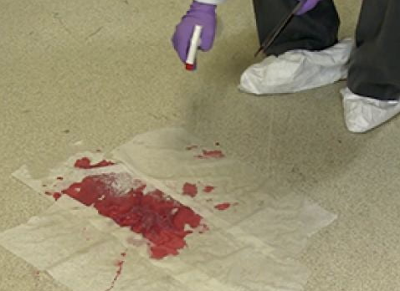Biological Spill Guidelines & Procedures
Planning for Spills
 The consequences of any spill of biological material can be minimized by performing all work on plastic-backed absorbent liner to absorb spills. A simple spill kit should be readily available and should include the following items:
The consequences of any spill of biological material can be minimized by performing all work on plastic-backed absorbent liner to absorb spills. A simple spill kit should be readily available and should include the following items:
- Chlorine bleach or some other concentrated disinfectant
- Package or roll of paper towels
- Autoclavable bag
- Latex or Nitrile gloves
- Forceps for picking up broken glass
- Biohazard Bag(s)
Spill Procedures
Spills inside a Biological Safety Cabinet
- LEAVE THE CABINET TURNED ON.
- Put on gloves and a lab coat.
- Spray or wipe cabinet walls, work surfaces, and equipment with disinfectant equivalent to a 1:10 bleach solution. If necessary, flood the work surface, as well as drain pans and catch basins below the work surface, with disinfectant.
- Wait at least 20 minutes.
- Soak up disinfectant and spill with paper towels. Drain catch basin into a container. Lift front exhaust grill and tray and wipe all surfaces. Ensure that no paper towels or solid debris are blown into the area beneath the grill.
- Autoclave all clean-up materials before disposal in the biohazardous waste container.
- Wash hands and any exposed surfaces thoroughly after the clean-up procedure.
Spill Procedure of Infectious Agents
Spills of infectious agents will be handled by copiously spraying 10 percent bleach (no more than one-day old) on the contaminated area. After five minutes, the liquid will be blotted up and the waste paper discarded in the biohazard container. Spills of noninfectious liquids (cell culture medium for example) will be handled as though they were infectious. Any spill of greater than one ml of infectious liquid or a spill of a virus stock of greater than 0.1 ml must be reported to the immediate supervisor and the EH&S director and RO or ARO (797-2892) if the spill occurs on a surface not protected by absorbent, plastic-backed lab mat. (Any spill contained by absorbent material on which it occurred need not be reported to the biological safety officer.) They will then determine if the current containment procedures are adequate to have protected personnel, or if some type of evacuation of the facility is warranted.
Standard Operating Procedure (SOP) for Clean up of Small Blood Spills
Follow these procedures for cleaning up spills of blood and blood products. The same procedures can be used for cleaning up other body fluids. For larger spills that go beyond your ability to clean with the supplies on hand, contact EH&S at 797-2892 and the University Police at 797-1939 or 911.
STEP 1: Required Personal Protective Equipment
Prior to beginning the clean up, don a pair of rubber, latex, PVC or similar type gloves and safety goggles.
STEP 2: Spill Kit Equipment
The following items may be needed in handling the spill:
- 10% bleach solution (or Lysol, virex or other EPA reg. Tuberculocidal)
- Gloves
- Biological waste bag
- Biohazard labels
- Leak-proof sharps containers if sharps are involved (needles, broken glass)
- Brush & dustpan, or tongs or forceps for picking up sharps
- Disinfectant wipes
STEP 3: Spill Decontamination Procedures
Cover the spill area with a paper towel and then pour freshly mixed 10 percent bleach and water solution. Allow solution to soak into the contaminated material. Work from the outside edges of the spill inward when applying the bleach solution. Any glass, needles, or other sharp objects that may puncture the skin will not be picked up by hand. Only mechanical means such as a brush and dustpan, tongs, or forceps are allowed. Wipe up bleached material with paper towels or absorbent pads. It may be necessary to use a scrub brush to remove the material if it impacted a hard porous surface such as concrete. If non-porous surfaces, such as a carpet, have been contaminated, an outside vendor may be needed to clean the area.
STEP 4: Disposal
Place bleached material, gloves and other disposable materials into a labeled biohazard bag and place into either another labeled biohazard bag or container. Call EH&S for a pickup (797-2892) or autoclave. Keep biohazard waste container in a secured area until received by EH&S.
STEP 5: Decontaminate RE-Useable Equipment
Decontaminate with the bleach solution all potentially contaminated re-useable tools or protective equipment used in the cleanup. This includes dustpans, brooms, forceps, buckets, etc. Anything that cannot be effectively cleaned (bleach solution must be able to make contact with all surfaces) must be disposed as waste. After the contaminated area has been cleaned, use fresh water to remove bleach residue from all surfaces.
STEP 6: Wash Your Hands
If hand-washing facilities are not available at the job site, use disinfectant wipes and then wash your hands as soon as possible.
Biohazard Exposure
If you believe you were exposed (skin puncture or splash to eyes or mucous membranes) to biohazard material that had not been decontaminated with the bleach solution, follow these recommended steps:
- Skin exposure: Vigorously wash affected skin with plenty of soap and water while removing contaminated clothing and shoes.
- Eye exposure: Wash eyes for at least 10 minutes with copious amounts of water, lifting the upper and lower eyelids occasionally.
- Contacting your supervisor, fill out a worker compensation form and visit Work Med for medical evaluation.

